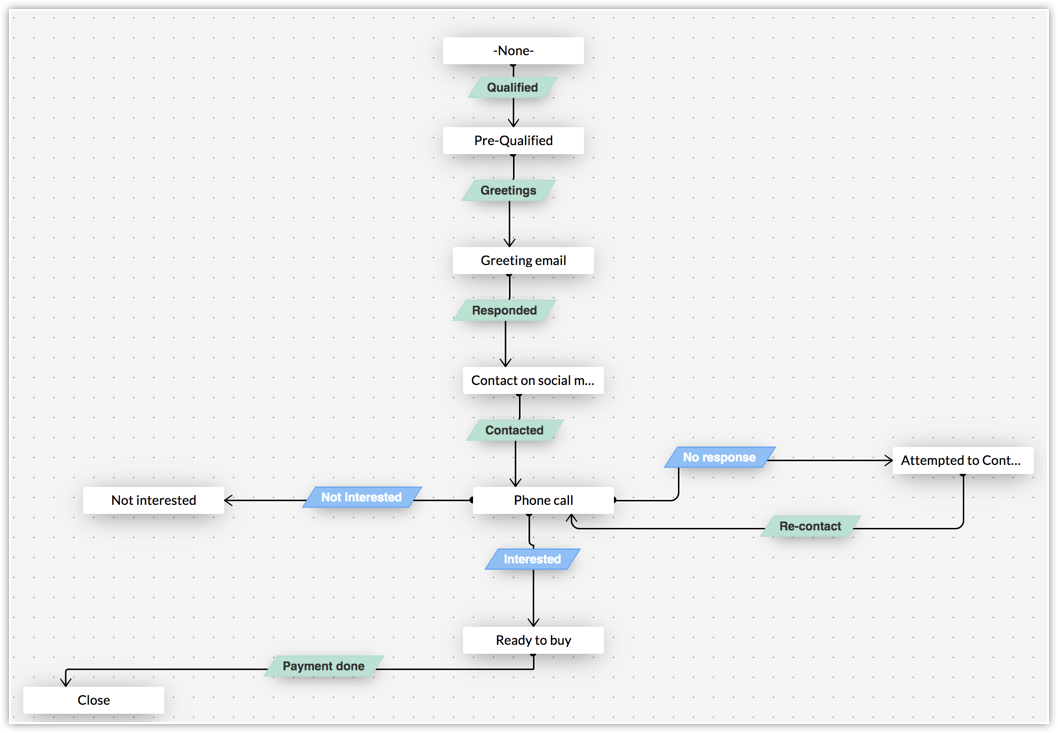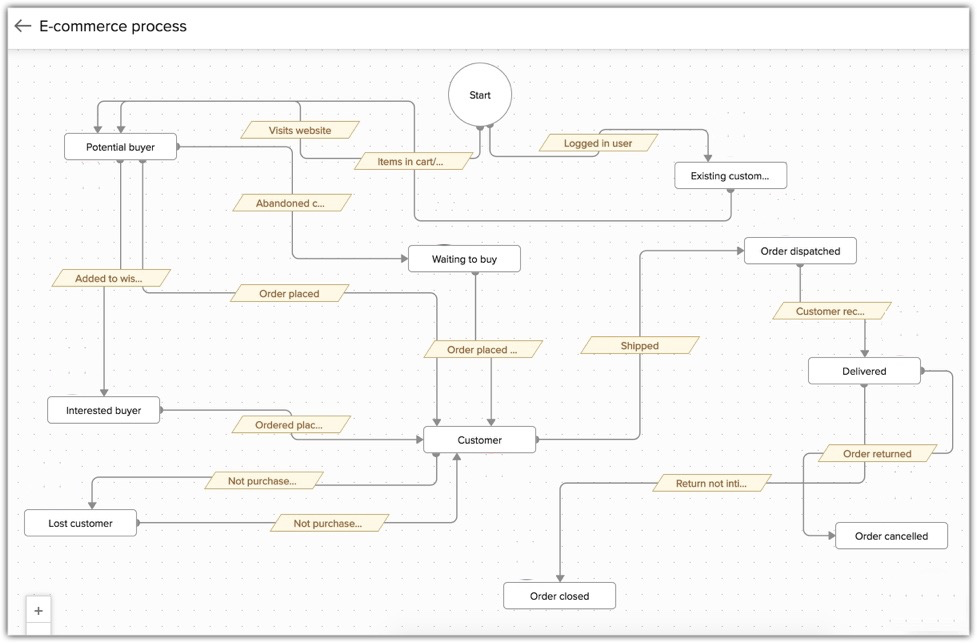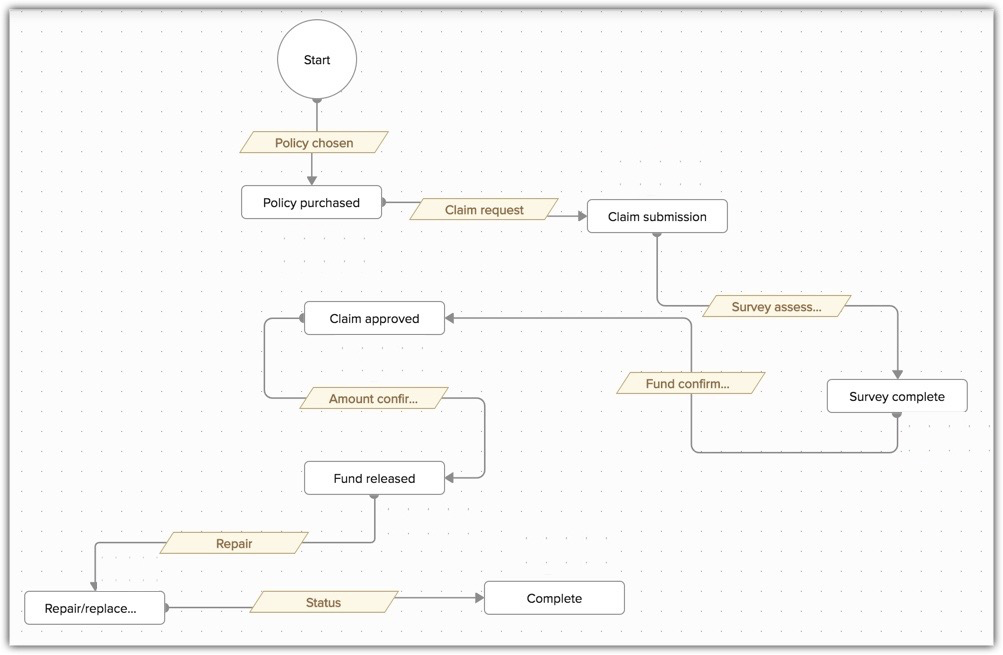The importance and benefits of sales cadences
- Last Updated : August 7, 2023
- 1.5K Views
- 8 Min Read

The first thing you do when you travel to a new place is to look up the location on a map. Similarly, if you decide to cook something you haven't cooked before you will refer to the recipe. This is because the navigation in the map and the method in the cookbook ensure a guaranteed result.
Your business is no different when it comes to needing proper guidance to navigate from the start to the end of a process.
There are various activities performed by different teams at every stage of a process in order to complete it. Processes such as lead qualification, customer acquisition, deal review, product delivery, or preparing a work order, each have a set of steps that must be performed in a certain sequence to complete the process. For example: A work order cannot be submitted without the job status and invoice date, a lead cannot be marked as uninterested unless two email follow-ups have been sent and a phone call has been made.
A rule book for each process that tells the individual what to do, when to do it, and how to do it can increase the efficiency of the process and the people performing it.
What is a sales cadence?
A sales cadence is a rule book for your business process. It defines the sequence of actions that a salesperson must perform in order to complete a process. It includes details of every activity like the emails that must be sent, which invoice to send, when to seek a manager's approval, etc. It is a digital map that ensures the salesperson knows the process and follows it to a T.
What does a sales cadence do?
A cadence is a close network of actions that defines required work items, making it easier for the task force to perform an activity. Before building a cadence, managers have to scrutinize the process to remove any action that does not add value. What is left at the end is the most reliable sequence which can be used as a reference by new or experienced members for optimum results.
Some common sales practices in business are:
Qualifying leads
Customer acquisition
Deal review
When a cadence is built for one of these processes, you need to take a closer look at the effectiveness of every activity and identify what works and what does not. For example, if sending a follow-up email for the third time in a day does not help in establishing contact with the lead while a phone call does, then you may choose to replace the third email activity with a phone call.
With proper scrutiny of your processes, you will be able to identify redundancies or mistiming of practices and change them for the better. Eventually, these changes will be reflected in the overall well-being of your business with better conversions, more deal closures, and improved team efficiency.
What type of cadence should you build?
The cadence that best suits your business depends on the sales model you follow. A shorter sales cycle with a lower deal amount and only a few decision makers is a transactional sales model. A cadence for this model would be simple with few touchpoints before the sale closes.
A sales cycle that is longer with a higher deal amount and which has at least 5–6 decision makers is a relational sales model. Usually, processes in larger companies are relational as the reps focus on building a stronger rapport with the customer, making the sales cycle longer with many touchpoints. A cadence for this type of sales model will be complex with well-defined sales activities at every stage and will have branches to allow different sales outreach tactics depending on the outcomes.
Let us read about the different types of cadence:
Simple sales cadence
Managers can use Blueprint to create best practices for their team members and guide them through a process by defining the activities they need to perform at each stage. The sales cadence can tell them when to send an email, which email template to send, the call script that should be used, or provide a checklist to make sure they have completed all the required activities before closing the stage.
Let's take a look at some examples of a simple sales cadence.
Inbound prospecting
The leads who have already expressed an interest in your business or who you have contacted in the past are easier to engage. They are aware of your brand so you can directly call them, send an email, or connect on social media. The frequency of subsequent contacts can be 1–2 days unless they explicitly ask you not to contact them. Here is an example of a sales cadence you might use in this situation:
Day 1 - Send greetings email and connect on social media
Day 2 - Call and try to book an appointment
Day 3 - Wait
Day 4 - Send follow-up email and call
Day 5 and 6 - Wait
Day 7 - Call to confirm if they are still interested
Day 8 - Close
Outbound lead qualification process
The leads are new and the sales rep needs to evaluate their interest before getting into the details. So they send an initial email. The subsequent contact attempts need to be paced carefully to avoid overwhelming the lead while remaining persistent.
Day 1 - Send email introducing yourself and the business
Day 2 - Call to check if they received the email and book an appointment
Day 5 - Connect on social media, call to collect other details
Day 9 - Send "Yet to hear from you" email
Day 12 - Call
Day 14 - Send a follow-up email and call
Day 15 - Leave a tweet
Day 16 - Call to check if they are interested
Day 18 - Send a "We hope to work with you in future" email
Branched sales cadence
Business with larger organizations takes longer as the reps have to spend a lot of time establishing a relationship with the customer. The sales outreach strategy varies based on the outcome of a call or an email. The managers can study the process to understand the different paths and create a sales cadence with multiple branches. The image below shows a sample branching sales cadence created using Blueprint.

Multi-branched complex sales cadence
A relational sales cycle with a B2B or B2C business model involves multiple processes starting from lead qualification through to product delivery before the sale closes. An array of sales activities are performed by multiple teams at each stage to proceed to the next stage.
The outcome of each stage will trigger a different outreach at the next stage, creating an intricate loop between the stages. For example, if the customer returns the product, the sales cycle reopens, triggering another loop of activities that involves the logistics, payments, and delivery teams.
A cadence to orchestrate such an intricate process is complex and requires a thorough understanding of the process and customer reactions at every stage to establish a link. CommandCenter connects stages from different processes bringing them altogether under one umbrella. The customer's response at each stage governs the direction the sales process will take.
Let's take a look at some examples of a multi-branched sales cadence.
#1. Product sale in ecommerce business
An ecommerce business can have different flows of events depending on the customer's response:
Website visit to product delivery: The sale of a product begins with an interested buyer visiting the website, adding an item to their cart, placing the order, making the payment, and then the order being dispatched, delivered, and closed. This is one way the process flow can take place.
Incomplete order: An alternate flow of events can take place if the customer exits the sales process in between or pauses at a stage. For example, they leave the items in their cart, they place the order but don't make a payment, or they leave your website without purchasing. In these situations, the company must engage the customers instead of letting them go. They can send emails reminding them of the items in their cart, prompting them to make a payment, or calling them to find if they wish to continue the transaction.
Order return: A third flow might occur if the customer decides to return the product. The sales team will reopen the deal and branch out to another process that handles refund and pickup.
Each of the above activities is managed by different teams. For the process to go on without interruption, a certain level of coordination is needed. The CommandCenter will ensure that these processes are interlinked and the message is passed on from one stage to another to adjust the flow of events depending on the customer's actions.

#2. Communication trail after customer journey ends
During a sales journey, there are several reasons to stay in touch with customers, such as sending newsletters or follow-up emails, making phone calls to update them about their delivery status, requesting feedback or address verification.
Some businesses, such as car insurance providers, need to communicate with their customers about other extended services like claim management or part replacement, which take place after the insurance is purchased.
Since these services are mostly provided by third-party vendors, key information can sometimes fall through the gaps without careful communication. An extended support from the company at this stage is a step towards building stronger relationships and loyalty among customers.
With the purchase of insurance, the sale is closed and policy renewal or premium collection is taken over by a separate division. In the event of a claim request, the claims department takes over and manages the process. Streamlined communication across the vendors and departments will help gather details on claim status, replacement cost, etc. that can be promptly shared with the customer.
A cadence can help the company bridge this communication gap and stay informed whenever a claims request is received and proactively get in touch with the vendors to monitor the progress of the claim filed by the customer. They can receive notifications at every stage and inform the customer about the timeline and other details.

Overall, a sales cadence makes your business processes far more efficient and organized, helping every member of your team stick to a well-curated journey for each customer, and ensuring no deal drops off the radar. It gives you better insight in to how your customers respond to your sales teams, empowering you to further refine and improve your approach. And, ultimately, it helps you win more deals and win over more customers.
Read more about the different types of cadence for different business models in our tutorials.


